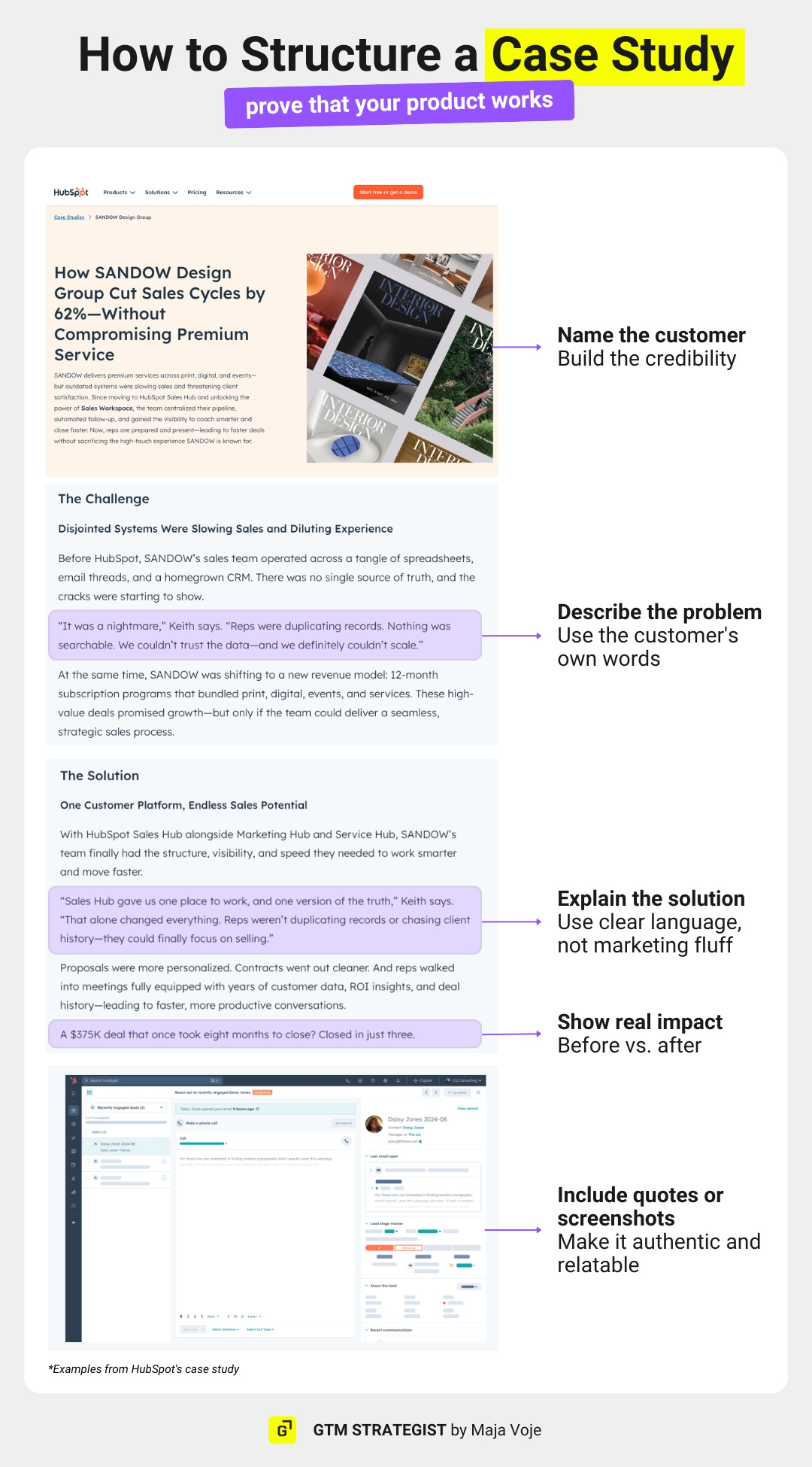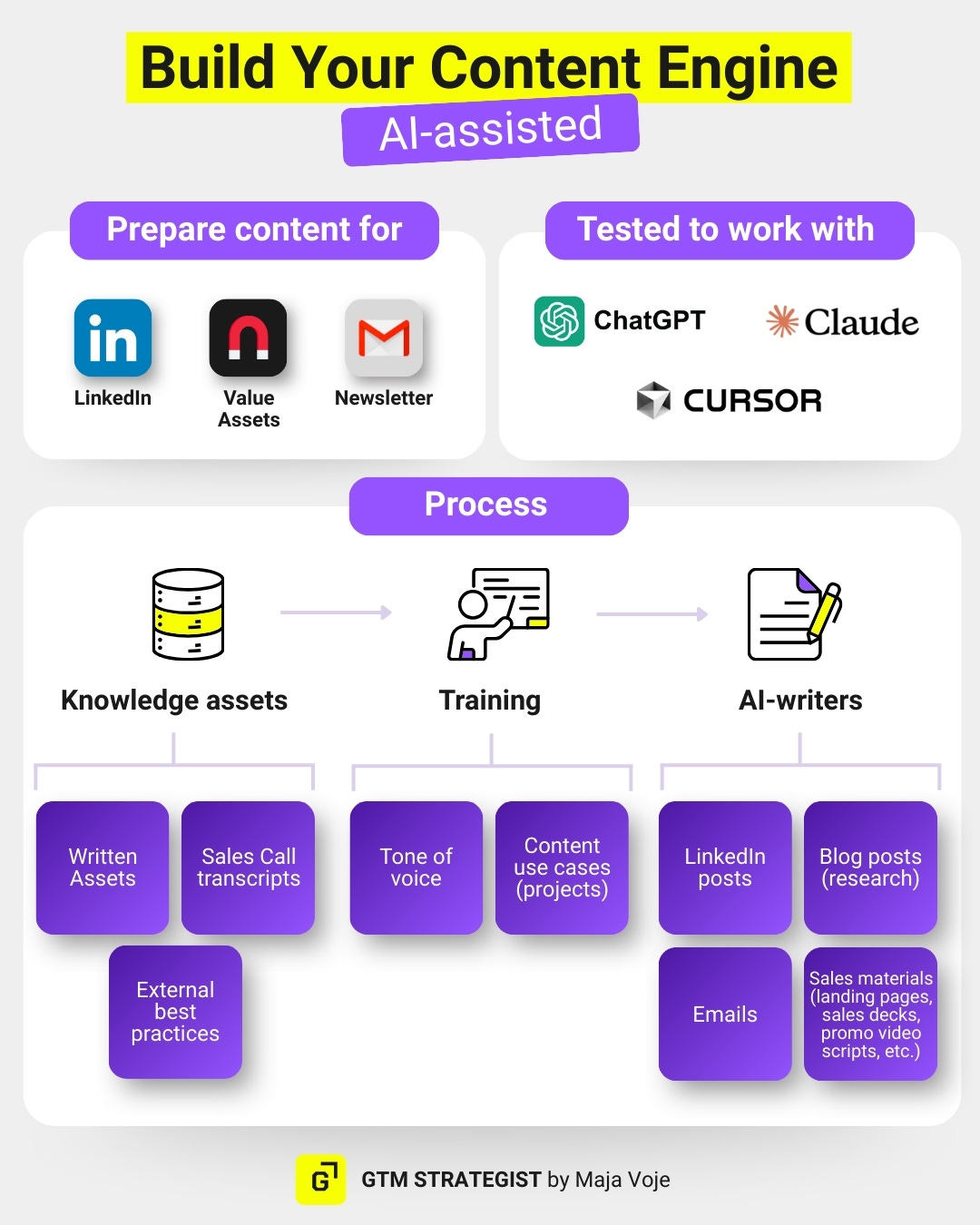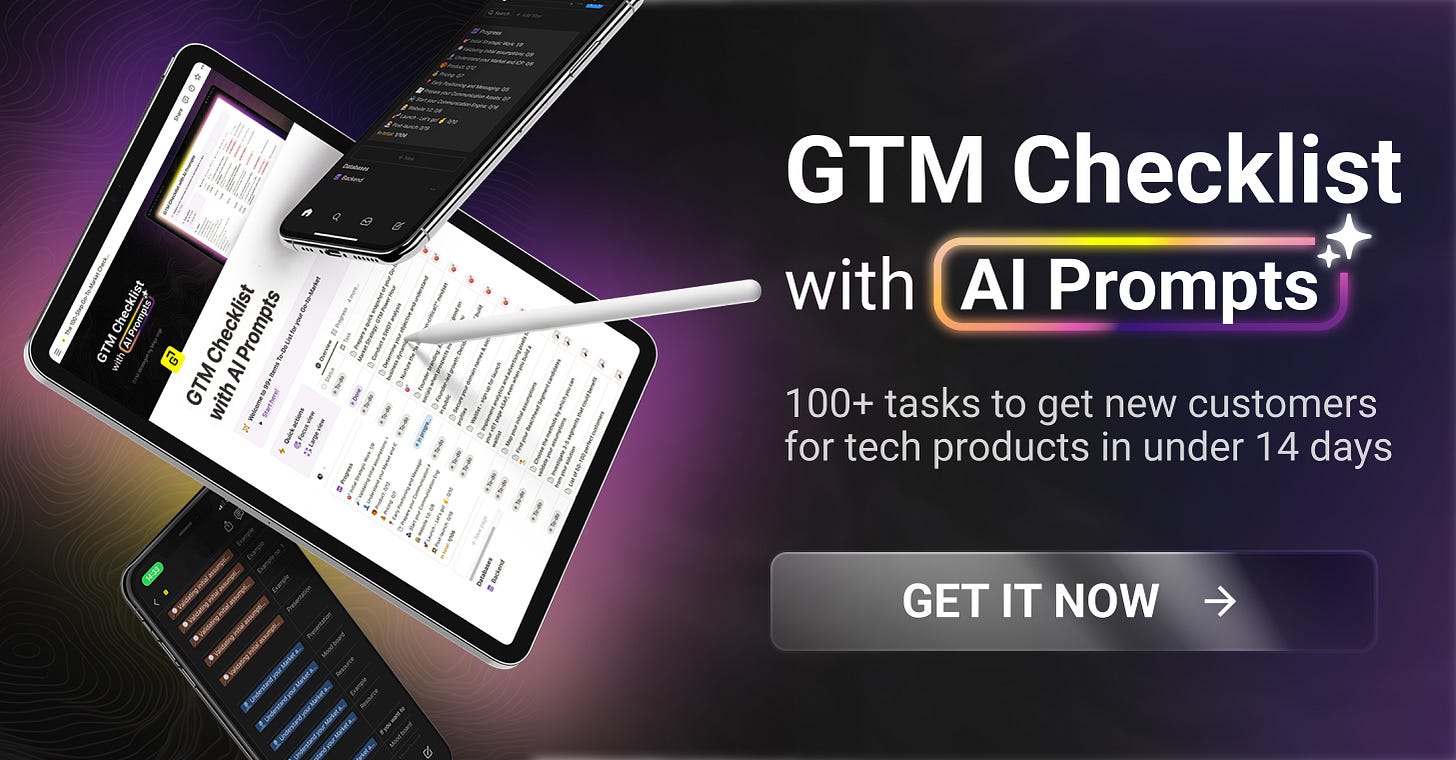5 GTM Programs I Am Implementing With My Teams
Tested on AI companies. Applicable to others too.
Dear GTM Strategist,
In 2025, it is harder than ever to find something that is working and scale it - or is it?
Contrarian hook masters on LinkedIn claim that outbound is dead, inbound is AI-polluted, ICPs suffer decision-making fatigue and carefully save their budgets for rainy days … Yet we are still here working and getting good results with my teams. Why?
Because we have to make it happen. Reading about what is not working and feeling depressed about where the world is going does not help. The only thing that helps is action: doing things, not facepalming about why you did not start two years ago when it was “easy.”
This is why I decided to take you on a journey to see what GTM programs we are implementing in Q2 and share some templates so that you can find something that works well for you and get ready to scale.
In this post, you will get a glimpse of:
Radical focus by orchestrating everything to hit OKRs
Outbound motion with a case study (AI enrichment)
AI-assisted inbound motions
Agencies as an ICP and/or partners?
Positioning/messaging beyond “we do X for Y” (multiple ICPs apply)
For reference, I mainly work with AI companies that are preparing for $5-20 million investment rounds and are ready to unlock their next million ARR. Exceptions apply if I really like the product and the team and think they have lots of potential.
1) OKRs as a prioritization tool
If you are an entrepreneur who is fundraising or a consultant, you will LOVE this one.
You have to hit your targets and the only way to do that is to stare at them every single day and prioritize the use of your resources (time, people, budget) through the lens of “how likely or not will this help me achieve my goals?” In other words, “Is it mission-critical?”
I’ve always been bullish on the OKR framework for goal-setting because if you don’t know where you are going, how will you know that you got there? But I took them to the extreme in this quarter - every task that goes into sprints has to support a specific OKR.
Steps to implement this logic:
Develop OKRs - that is “the easy part” - use this free template.
Critically evaluate what “great looks like” and bake it into your OKRs. Avoid vague input metrics (like “publish 4 blog posts and 20 LinkedIn posts” - honey, I can do that in 1 hour with ChatGPT, but it is not what great looks like 🤠). A task can be done or it can be done right - you curate what is done right based on your standards of execution excellence.
Align them with your stakeholders - get feedback and ensure the key results sensibly add up to the objective. It will shock you how helpful that will be - you will unlock so much buy-in and get help.
Import your OKRs to your project management tool (most of my teams use ClickUp or Notion) - make sure you make them actionable, add owners and tasks.
Connect OKRs with your sprints so that all the tasks we add there have a streamlined way to get to operations.
Make a plan (“roadmap”) for tackling your objectives and build assets and processes needed to execute key results if needed.
Start every GTM sprint by reviewing OKRs. When tackling objectives with your team, make sure that every action point you make adds up to OKRs. If not, I would double-think whether to invest my resources there. OKRs are such a great tool for keeping focus.
Adjust if necessary - in GTM, nothing is set in stone. Every week, you learn something new. But NEVER adjust OKRs because of execution issues - you can always find a better agency, consultant, or change processes to make it happen. Don’t give up easily just because some people are too lazy or distracted to get the job done.
Trust me. This one is a game-changer - if you will ONLY take that from this whole article, you will see a positive change if you know what you are doing in business.
I even use this system in my personal life and have trained a voice ChatGPT personal assistant to give me pep talks whenever I am not feeling like doing another outreach, post, or meeting. Its generic voice: “Remember, every email you send, you are one step closer to your goals,” weirdly gets me fired up to stick to my goals even without immediate gratification.
Now, back to tactics.
2) Outbound with a hook - Case study
Every company I work with has done something valuable before we started working together. Turning those wins into case studies helps attract similar clients who need the same solution.
With our teams, we are building a lead list based on targeted signals that a company might be interesting, and the outbound sequence looks a little bit like this:
Reference to the signal (confirming the problem)
Building authority
Adding value with the case study
Getting them to demos
But as always, the devil is in the details. Here are some mistakes I often capture when coaching my teams on how to prepare a high-quality case study.
Avoid these mistakes with a case study and outbound:
ChatGPT writes a case study based on a competitor/company you like. That is a great start - but you will have to add more “meat to it”. Think steps, screenshots of solution architecture, interview with a client, outlining resources needed… Clarify whatever is a common concern or question that you get on a call.
Just pitching like “Hello - got problem with downtime in your plant? We have solved this successfully for a company X, here is a case study link.” Wrong. You literally squeezed all the outreach sequence within the same message - you neither got their confirmation of a problem nor their permission to share this high-value asset with them.
Smashing a blog post of LinkedIn links to attract attention - come on, you can be more exclusive and give them value beyond sending them an infographic that you have created for your LinkedIn post. That is just underwhelming - there is nothing exclusive in it for them.
Overall, I am a fan of designing case studies well and clarifying in the call to action what they can expect if they book a demo.
Don’t just publish your case studies to your blog or website and “let them live their own life”. It doesn’t work that way; you have to bring relevant traffic. How? Make a distribution plan - whatever is relevant to your ICP: outreach, events, webinars, feature the link on your LinkedIn profile, make it more prominent on the website… You got this!
3) AI-assisted inbound motion
Still with me? Good. Let me introduce the best seller in Q2: AI-assisted inbound motion. It’s so hard to find competent copywriters who understand your domain and the channel that you are trying to dominate with your thought leadership.
Let’s be honest, for an average person who could assist you with copywriting for thought leadership, it takes 3-6 months to “get the industry” - if they are motivated to learn. And most of the early-to-mid-stage GTM companies don’t have the budgets and skills to attract world-class talent.
So I like to team up with engineers to create custom AI content writers for my teams. We have to do something, and in most cases, the chances of training AI well are higher than getting decent people to work on our technical content.
This is an MVP that we usually implement:
This is super easy - everybody can do it. You just need a premium access to AI of your choice. Now - the fun part begins: we are trying to connect this “engine” with other processes such as getting insights from the customers, preparing texts for images, validating designs, generating content out of “thin air” on the go - super fun field to play in and it is already bringing good results for my technical teams. By now, it cuts 60% of the time needed for content. Hopefully we can get this number up to 80% by September.
I was thinking a lot about all-in-one solutions lately - these are the conversations I had with my partners Miro, Amplitude, Tidio, Momentum… Our ICP does not need a combo of 70 different tools to get the job done. Ideally, we can cover this within a single streamlined workflow that leads to success. We are trying to frankenstein our way into this philosophy with these builds - so grateful to work with amazing engineers who can make this happen. 🙏
4) Agencies as an ICP and/or partners?
First rule of quick adoption: don’t change the existing workflows. Great that your AI solution can reduce 90% of the time the clerk will need to process a form, but the larger the organization is, the more likely they will need something more custom to exactly fit their existing workflows. Plus, maybe you will have to work hand-in-hand with an external service provider (agency, advisors, consultant, “Deloitte”...) to make it happen. An agency that implements your product can become your gateway to customers.
Surprisingly, I have seen this pattern at 50% of B2B AI agents that I am working with. We are not killing the middleman - the middleman is actually a huge amplifier of traction. So much so that some of my teams have even deployed a whitelabel solution and added multiple accounts fields to their products to capture their needs.
How they treat “the middleman” is different - some think of them as adoption partners and give them discounts for clients + fees. Others just roll out a pricing package for them. But in any case - pay close attention if “agencies” are within your early adopters bucket. If they are, hop on at least 20-50 interviews to know how they are using the solutions, what their problems are, and what an ideal solution for them looks like.
I have seen that a lot in the outbound ecosystem- Clay’s because of the head segment were outbound agencies, before they expanded to in-house teams. Heyreach, LinkedIn outbound tool has a pricing purposefully tailored for agencies + what they call “a generous affiliate program”, and Warmly is just updating their partnership program, leaning heavily on agencies - more info soon.
The biggest mistake I see here is “set it and forget it”. Every day, I get “are you open for affiliate partnerships” pitches and by now, I do not even bother to get back. Why would I care, what is in it for me for my clients and me, do I even see the use case of this solution?
Less is more when it comes to that. Instead of pitching 400 agencies a week, hand-select a list of partners that you will white-glove through the first batch of partner program and secure successful implementations. You are still learning at this point and working hand in hand with partners is the best way to start crafting a partnership process that will one day be a repeatable and scalable GTM motion.
5) Value props for the win: Positioning and messaging beyond ICPs
As AI agents are moving beyond “we do X for Y”, as we are expanding with new ICPs and adding partners to the decision-making process, our positioning and messaging should evolve. We work with a lot of VERY technical (I mean I have to call three friends who work in the space to really get it) products and I love that because it is one of the best possible intellectual challenges for me to tackle.
I love the idea of vertical AI agents and I have written about that extensively already for Userpilot’s PITT, but lately we got a lot of platforms for building AI agents and complex enterprise-grade solutions to our client mix, so we had to revamp some of our models to serve the multiple ICPs (multiple value propositions scenarios) better.
The lion's share of our work is to simplify the value proposition (what is in it for the customer - what is your promise) and provide a structure of information that backs up these claims with benefits, features, and pieces of social proof (evidence). My partner Anze leads these projects and here is a snippet of the process he does with our clients:
There is a 6th program in the making: three clients are thinking about open-sourcing their AI agents instead of offering a free trial/demo, but it is too soon to dive into that because it is still in the making.
And #7 could be pricing for AI solution to nail the credit system … hehe - OK, I’ll stop - geeking out now
Hope you enjoyed this one.
What is working well for you so far in 2025?
Hit a comment and help others to build predictable and scalable ways to find customers.
Templates and workshop screenshots in this article are available here.
If you would like to work together, I am pretty stretched ATM, but feel free to let me know what you need to make your GTM work for you (not vice versa) - simply hit reply if you are reading on email or send me a DM on LinkedIn. I’ll try my best to help or offer you a trusted and verified recommendation for someone who can help.
📘 New to GTM? Learn fundamentals. Get my best-selling GTM Strategist book that helped 9,500+ companies to go to market with confidence - frameworks and online course included.
✅ Need ready-to-use GTM assets and AI prompts? Get the 100-Step GTM Checklist with proven website templates, sales decks, landing pages, outbound sequences, LinkedIn post frameworks, email sequences, and 20+ workshops you can immediately run with your team.
🏅 Are you in charge of GTM and responsible for leading others? Grab the GTM Masterclass (6 hours of training, end-to-end GTM explained on examples, guided workshops) to get your team up and running in no time.
🤝 Want to work together? ⏩ Check out the options and let me know how we can join forces.








